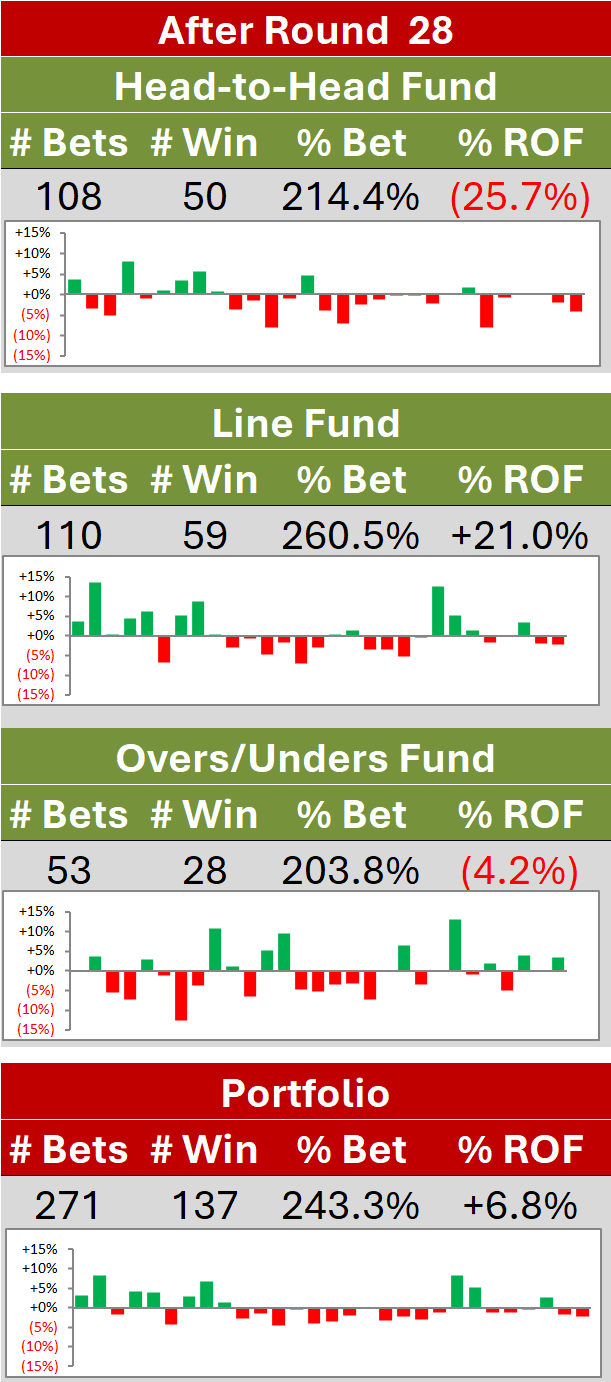2022 : Simulating the Final Ladder After Round 14
/The latest simulations - both Standard and Heretical - suggest that the teams can be roughly grouped as follows:
Brisbane Lions, Fremantle, and Melbourne: virtually assured of a Top 8 finish, 65-80% chances for Top 4, and 20-30% chances for the Minor Premiership
Geelong: virtually assured of a Top 8 finish, 60% chances for Top 4, and around 15% chances for the Minor Premiership
Carlton, Sydney, Richmond, and Collingwood: 60-75% chance of playing Finals, 20-35% chance of a Top 4 finish, 1-5% chances for Minor Premiership
St Kilda, Western Bulldogs, and Gold Coast: 40-50% chance of playing Finals, 8-13% chance of a Top 4 finish, extreme longshots for Minor Premiership
Port Adelaide: 12-13% chance of playing Finals, longshots for a Top 4 finish
Adelaide, Hawthorn, and GWS: 0.2-0.8% chance of playing Finals
Essendon: extreme longshots to play Finals
North Melbourne and West Coast: likely to fight for the Spoon
(For details about the methodologies I’ve used, see this earlier blog).
LADDER FINISHES
The ladder projections using the Standard methodology (aka “cold” sims) appear on the left, and those using the Heretical methodology (aka “hot” sims) appear on the right.
Looking first just at the Standard Methodology, we see that the range of Expected Wins now runs from 3.3 to 15.3, which has grown a little from last week’s range of 3.6 to 15.1. We also see that 11 teams are still expected to finish with a win percentage above 50%.
The biggest decline in Expected Win tally came this week for St Kilda (-1), while the biggest increase came for Essendon(+0.9).
In terms of Top 8 chances, there were only three double-digit changes in estimate, including Richmond’s and Western Bulldogs’ +13% points, and St Kilda’s -26% points.
Comparing the results for the Standard and Heretical Methodologies we find:
A larger range of Expected Wins from the Heretical approach (2.4 to 15.5 wins)
A similar ordering of the teams in terms of Expected Wins with only Carlton a couple of spots higher under the Standard Methodology
Broadly similar estimates for the changes in teams’ Finals chances
TEAM AND POSITION CONCENTRATION
The HHI figures for the most recent simulation replicates appear below, with those from the Standard methodology on the top, and those from the Heretical methodology on the bottom. (For information about the HHI, also see that previous blog linked to earlier).
STANDARD METHODOLOGY
heretical methodology
Again only a small reduction in average uncertainty this week, with a handful of teams becoming less certain of their eventual ladder position, especially the Western Bulldogs and Essendon.
Both methods suggest that teams are, on average, still effectively competing for about 7.5 different ladder positions, and both have most teams competing for between 5 and 11 positions, the exceptions being Essendon, North Melbourne, and West Coast.
standard methodology
heretical methodology
These tables also imply a very modest reduction in uncertainty this week, and suggest that there are now 5 to 9 teams effectively competing for each of the Top 3 spots.
They also have the average ladder position with effectively around 7.5 teams likely to fill it, and with most ladder positions effectively expecting anywhere between 5 and 11 teams to be competing for them. The exceptions amongst the ladder positions are 15th through 18th.
Most uncertainty is now associated with positions 4th through 11th.
WINS AND LADDER POSITION
Here’s an updated view of the distribution of team wins and final ladder position, based on the Standard Methodology
If we, again, sum across all the teams, we can see how many wins are most likely for each ladder position, as shown in the chart below.
It’s now the case that 13 wins (54% of replicates) is considerably more likely than 12 wins (35% of replicates) to be associated with the team that finishes 8th. For the team finishing 4th, 14 wins (52% of replicates) is now more likely than 15 wins (37% of replicates).
This, of course, varies by team, and in the chart below we look at how likely it is that a given team plays Finals if it records a particular number of wins, and how likely that outcome is. In the first chart we use the results from the Standard Methodology, and in the second chart from the Heretical Methodology.
We see that teams are less than about 2% chances of playing Finals under either methodology with only 11 wins, and 10 to 40% chances of playing Finals with exactly 12 wins under either methodology. With 13 wins, a team is a 75-95% chance of playing Finals under the Standard Methodology, and a 60-90% chance under the Heretical Methodology.
Repeating the analysis for finishing in the Top 4.
Here we find, again, somewhat different estimates depending on the methodology we choose. Under the Standard Methodology, 13 wins is associated with about 0.5 to 2% chances of a Top 4 finish, 14 wins with 20 to 55% chances, and 15 wins with 85 to 95% chances.
(Note that there is a better than even chance that 4th spot will be decided on percentages, so there will be a number of replicates where a team finishes tied in 4th on 14 wins but misses out on percentage)
Under the Heretical Methodology, more wins are associated with higher-finishing teams, and the equivalent percentage ranges are 0 to 1% for 13 wins, 5 to 30% for 14 wins, and 60 to 90% for 15 wins.
LIKELY IMPORTANCE OF PERCENTAGE
Next, we’ll use the Standard simulations to again investigate the estimated likelihood that any given pair of ladder positions be determined after Round 23 based on percentage.
The simulations are now suggesting there is a slightly better than even-money chance that 8th and 9th on the final home and away ladder will be separated only on the basis of percentage, and a little more than a 1-in-5 chance that 8th and 10th will also only be separated on that basis.
There is also a better than even-money chance that 4th and 5th will be decided on percentages, and a 3-in-10 chance that this will be how the Minor Premiership is decided.
IMPACT OF NEXT 5 GAMES ON TEAMS’ FINALS CHANCES
Finally, we’ll again investigate, using both the Standard (top chart) and the Heretical )bottom chart) methodology simulations, what each team’s estimated chances of playing Finals will be in five games’ time, depending on how many of those five games that team ends up winning.
We see that most teams’ chances of playing Finals still increase only if they win at least 3 of their next 5 games, the exceptions being Adelaide, Essendon, GWS, Hawthorn, North Melbourne, and West Coast whose chances would only remain roughly the same with 3 wins. Richmond see their chances only increase very slightly with 3 wins under the Standard Methodology, and fall with 3 wins under the Heretical Methodology.



